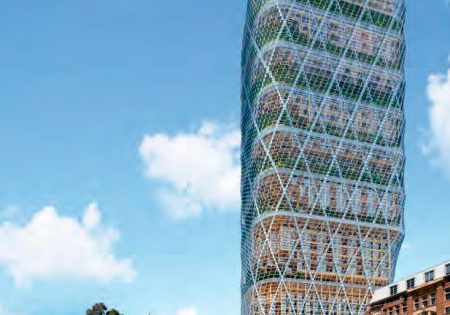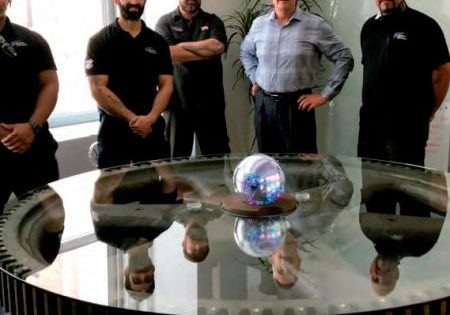Safety Within
Sep 1, 2020

Formula Systems offers solution for sanitizing the air and surfaces in elevator cars.
by Steve Whittall
Elevators enable urban growth. Without the ability to develop upward, space in our densely populated cities is severely limited. Over the years, elevator development has been focused on efficiency and — importantly — passenger safety. This has led to the development of familiar features such as safety brakes, door sensors, door-closing devices, interlocks, pit buffers and many more.
The coronavirus pandemic has had a profound effect on the economy, not least in the mandatory closure of businesses and offices to control the spread of the disease. As lockdown eases, elevators will be critical to the reopening of commercial developments, such as shopping malls and offices, which will enable people to get back to work. However, this presents a challenge: small, enclosed spaces are potential hotspots for cross-contamination.
Formula Systems’ new SafeSpace™ is specifically designed to eliminate airborne and surface viruses and bacteria inside elevator cars. The coronavirus has had an unprecedented effect on the world’s population. SafeSpace is intended to give confidence to elevator users, ensuring their numbers will return to normal levels.
The Problems
The typical mode of coronavirus transmission is via droplets expelled by an infected person when in close proximity to others. Viral particles can survive on surfaces (including stainless steel and plastic — materials commonly used in elevator interiors) for days.
Cross-contamination is most virulent in enclosed areas with limited ventilation. The elevator car is, therefore, an ideal environment for viruses and bacteria to breed and spread.
The key sources of cross-contamination are:
- Ambient air: the coronavirus spreads primarily via airborne droplets larger than 5 microns. These are most commonly produced when a person sneezes, coughs or speaks. While scientists do not consider this to be airborne transmission in the strictest definition of the term, several studies have identified live coronavirus particles in the air of places with low or limited airflow.
- Surface contamination: this may present an even bigger opportunity for cross-contamination. The survival of the coronavirus on surfaces is dependent on several factors —mainly temperature, humidity and surface materials. Just as elevators are designed to provide a comfortable environment for passengers, it is reasonable to suppose that this same environment would provide ideal conditions for the coronavirus to thrive. Studies show that viral particles last longer on some materials, including stainless steel and plastic. It is reasonable, therefore, to assume that frequently touched surfaces, such as elevator buttons, support rails, car doors and walls, will become hotspots for harboring harmful viruses and bacteria.
Solutions for Decontamination
Decontamination of enclosed spaces is commonly dealt with by using alcohol-based wipes, bleach, dry steam cleaning or disinfectant fogging. While these are effective methods of sanitizing surfaces, the process can only be carried out when the area is unoccupied due to the harmful nature of the agents used. As soon as the cleaning process is completed, and the space is occupied again, it is quickly recontaminated.
SafeSpace can be installed between the car’s roof and ceiling, with just two small vents visible to passengers. The unit provides a continuous flow of safe, sanitizing plasma to significantly reduce viral, bacterial and particulate contamination. The same technology is already in use in many ambulances in the U.K. To further enhance passenger confidence, a message stating that the car is fitted with a device to protect from cross-contamination can be linked to the car’s voice annunciator or projected onto the car wall.
How It Works
SafeSpace combines a dual-waveband ultraviolet (UV) lamp, photocatalytic plates and a fan to produce a plasma that cleanses ambient air and coats exposed surfaces, killing harmful viruses and bacteria. The air passes through the unit and is drawn over the UV bulbs and catalytic plates, producing a twofold effect:
Internal
Germicidal irradiation by dual UV lights kills microorganisms (bacteria, viruses and mold) by disrupting their DNA and removing their reproductive capabilities.
Photocatalytic oxidation occurs when the UV light reacts with a titanium dioxide (TiO2) catalyst to form highly reactive but short-lived oxidizing hydroxyl radicals, which break down volatile organic compounds (VOCs). The interaction of the dual UV wavebands with the TiO2 heterogeneous catalyst both creates and breaks down oxygen molecules (O2), transforming
oxygen into a highly reactive state of ozone (O3) and superoxide ions, which leave the unit as “plasma quatro,” a gas with very good sanitizing capabilities.
Transmitted Technology (Plasma Quatro)
The negatively charged superoxide ions charge airborne contaminants, causing them to cluster together and fall as they become too heavy, aiding all other processes. This can remove airborne particulates down to 0.0001 microns, which is better than a high-efficiency particulate air filter. The targeted ozone produced via the special lamp reaches areas that are difficult to access, breaking down contamination in the air and on exposed
surfaces. Ozone (O3) damages the cell wall of microorganisms, halting reproduction and destroying the cell. While O3 in high concentrations can cause health effects, the O3 produced by SafeSpace is present at less than 0.015 parts per million – about hall the amount of 03 in the air after a thunderstorm.
The Science of Photocatalytic Disinfection (PCD)
Chemical reactions require certain activation energies. The combination of short-waveband UV light (UV-C, which occurs in the 100-280 nm part of the light spectrum) and a catalyst (Ti02 semiconductor coating) that speeds up the reaction provides optimal conditions for PCO. This produces a disinfecting plasma.
Efficacy
SafeSpace technology has been tested by the U.K. government’s public health laboratories and third-party microbiology laboratories, where it has been shown to kill a wide variety of viruses, bacteria, ftmgal spores and airborne particulates.
PCD has been the subject of hundreds of peer-reviewed studies and been proven to kill viruses in the coronavirus family.
With the rapid onset of the coronavirus pandemic, the fuJI impact of the “new normal” is stiJI unfolding. It is certain, however, that areas where people group together in close proximity will continue to concern. The perception of elevator cars being a hotspot for the spread of viruses must be managed. The Formula Systems SafeSpace sterilizing unit, together with established hygiene practices, can significantly reduce crosscontamination within the elevator car and restore passenger confidence in elevator use.
Steve Whittall: Is Group director of Operations for t he Airdri Group, parent company of Formula Systems.
Cellular Modem
Janus has introduced the LTE910XF v7.00 Category-1 embedded “X”-footprint cellular modem for remote monitoring and other applications. It integrates Telit’s LE910-NA1 SSKU LTE module as its cellular engine to operate in LTE bands B2, B4, B5, B12 and B13. The company calls it a “solution for LTE Internet of Things (IoT) connectivity” that can be mounted directly onto a printed circuit board or mounted in a DIP socket or header.
Janus Category 1 modems are lower-power and lower-bandwidth units specifically designed for IoT applications. Verizon’s “end device” certification allows it to be integrated into any new or existing hardware applications via its industry standard 20-pin DIP configuration. The LTE910XF V7.00 is also AT&T and PTCRB certified, which allows it to be used on any North American cellular network. It is Federal Communications Commission and Industry Canada approved.
Call Panel Cover
BayCab, a division of Baywood Interiors Ltd. in Kitchener, Canada, has released the BayShield-19 elevator call panel hygiene cover. Designed to help protect passengers from COVID-19, while continuing to allow them to make selections via touch, the product is made from flame-retardant materials. A poly/fabric border with Velcro® frames the clear PVC, which provides a physical shield intended for easy, toolless installation and cleaning without damage or modification to the call panel. Custom sizes are available
Power Supplies With Monitoring
WAGO’s Pro 2 Power Supplies include six units with a range of 120-960 W and an energy conversion efficiency of up to 96%. The company says they incorporate an interface allowing them to be tailored to any application requirement. The units also offer monitoring functions that provide continuous power-supply data and signal errors for application monitoring. They are designed for easy fieldbus connection with snap-on-type communication modules with WAGO’s TopBoost and PowerBoost capabilities for maximum system uptime. TopBoost protects for up to 15 ms at 600% extra output current compared to that of conventional circuit breakers. PowerBoost provides an extra 150% output current for 5 s to provide reserve power.
Flexible Surface System
Fridley, Minnesota-based Stylmark has launched the AXIA™ Flexible Surface System. The aluminum architectural extrusion system was created to enhance surfaces for commercial, hospitality and retail environments, including elevator cab interiors. Panels are available in five styles in stock sizes of 12 ft X 4 in., though the company also custom fabricates them to fit. It is intended to complement Stylmark’s TrimMaker® aluminum extrusion product line. Like those products, AXIA can be anodized for color matching.
Fundraising Stickers
The Elevator Escalator Safety Foundation (EESF) is now offering customizable masked emoji stickers from its new online store. Prompted by the COVID-19 pandemic forcing cancellation of 2020’s EESF fundraiser events, the Foundation hopes to make up funds from them through the sale of the stickers. EESF adds, “Public safety guidelines now include social distancing, but that is virtually impossible in an elevator. EESF wants to help get the word out that masks should (and in most facilities are required [to]) be worn in elevators.”
Touchless, Voice-Controlled Home Lift
Crevalcore, Italy-based NOVA Elevators has released VOCAL SUITE, a touchless, voice-controlled home lift. It is intended to allow passengers to avoid every contact with surfaces in the elevators of a smart home, low-rise buildings and healthcare facilities. Touting an “interactive experience,” NOVA CEO Fabrizio Nicoli said the product allows the passenger “to call the home lift and to operate it, to activate the alarm bell, to customize the call with a ‘secret keyword,’ to add bespoke background music or ask the system the latest news, the weather forecast and more.”
VOCAL SUITE had been in the works for several months when COVID-19 became a pandemic. Installation needs only a Wi-Fi connection with a 2.4-GHz band frequency and DSL internet or optical fiber. It is available with reserved call to replace the mechanical enabling key at landings. It can also include a bespoke voice call to activate the lift for individual guests. It is available for up to six landings in English, German, Italian and French.
Get more of Elevator World. Sign up for our free e-newsletter.








